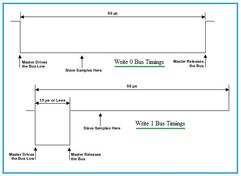
1-Wire Communication Protocol: Single Wire Interface Overview
Explore the 1-Wire protocol, developed by Dallas Semiconductor, which uses a single wire for data transmission, making it cost-effective for diverse applications.
Showing 25 posts (Page 1 of 4)
Advertisement

Explore the 1-Wire protocol, developed by Dallas Semiconductor, which uses a single wire for data transmission, making it cost-effective for diverse applications.

Explore frequently asked 10 questions and answers about Thunderbolt technology, including speed, compatibility, and differences between HDMI, USB, and Firewire.

Explore 5 key advantages and disadvantages of 1-Wire interface protocol, including benefits like simple wiring and cost and drawbacks like slow speed and software complexity.

Explore 5 key advantages and disadvantages of RS485 serial communication, including distance, speed, noise immunity, and limitations like wiring complexity and data transfer.

Explore 5-10 advantages and disadvantages of PCIe (PCI Express) compared to traditional PCI, including speed, bandwidth, and compatibility.

Learn about the Uu, NG-1U, and NG-1C interfaces in 5G networks, their functions within the 5G RAN architecture, and their roles in data and control planes.

Explore the 5G network architecture and its reference points (NG1-NG15), defining the interfaces between functional blocks in a 5G NR network.
VHDL code for interfacing with a 7-segment display, including entity declaration and architecture implementation.

Explore ADC DAC interfacing with FPGA, including VHDL code examples for reading data from ADC to receive and writing data to DAC for transmit.

Explore the benefits and drawbacks of multi-touch technology, including its applications and limitations in various environments.
A comparison of AHCI and NVMe, two interface technologies for connecting storage devices. Learn about their features, benefits, and performance differences.

Explore the pros and cons of AHCI (Advanced Host Controller Interface) for SATA drives. Learn about its features, benefits, and drawbacks compared to newer technologies.

Explore the key differences between AMBA AHB and AXI bus architectures, including architecture, throughput, latency, and power consumption. Understand their applications in high-performance systems.

Learn how to interface an Arduino board with a gyro sensor for rotational motion detection. Includes wiring diagram, working principle, and example Arduino code.

Learn how to connect a pH sensor to an Arduino for quick liquid acidity measurements. Includes a diagram, code, and explanation of working principles.

Explore a detailed list of sensors used with Arduino boards, including temperature, humidity, ultrasonic, and more. Learn about their applications and how they interface with Arduino.

Explore CAN interface basics, its applications, and pin configurations. Learn how CAN enables communication between devices without a central host.

Explore 5 advantages and 3 disadvantages of capacitive touch screens, including their benefits such as sensitivity, visual clarity and limitations like glove incompatibility.

Explore CMOS to RS232 and RS232 to CMOS converters, their components, pinouts, and applications. Understand voltage level differences for seamless communication.

Explore the pros and cons of digital potentiometers compared to analog potentiometers, including reliability, size, temperature sensitivity, and current handling.

Learn about the DigRF interface, a standard for connecting baseband and RF ICs in mobile devices. Covers versions, specifications, and applications.
Explore the key differences between ECL, LVDS, and CML interfaces. Learn about their characteristics, advantages, and disadvantages for high-speed data transmission.

Explore the differences between eMMC and UFS storage, comparing speed, performance, energy consumption, and more to understand which is better for your device.
Explore the key distinctions between Firewire and USB interfaces, including data rates, voltage, and network types. Understand their historical context and applications.
A basic comparison of GPIB (IEEE-488) and serial (RS232, RS485) interfaces, highlighting key differences in speed, distance, and device support.
Advertisement